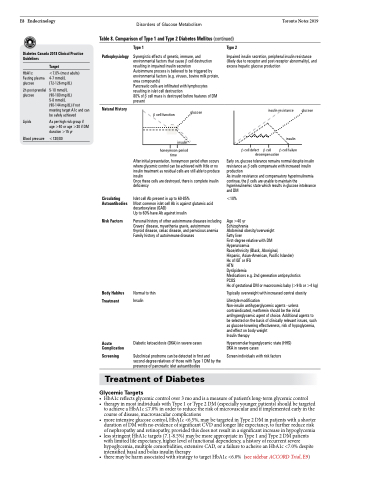Page 250 - TNFlipTest
P. 250
E8 Endocrinology
Diabetes Canada 2018 Clinical Practice Guidelines
Disorders of Glucose Metabolism Toronto Notes 2019 Table 8. Comparison of Type 1 and Type 2 Diabetes Mellitus (continued)
Target
<7.0% (most adults) 4-7 mmol/L
(72-126 mg/dL)
5-10 mmol/L
(90-180 mg/dL)
5-8 mmol/L
(90-144 mg/dL) if not meeting target A1c and can be safely achieved
As per high risk group if age>40orage>30ifDM duration >15 yr
<130/80
Pathophysiology
Natural History
Type 1
Synergistic effects of genetic, immune, and environmental factors that cause β cell destruction resulting in impaired insulin secretion
Autoimmune process is believed to be triggered by environmental factors (e.g. viruses, bovine milk protein, urea compounds)
Pancreatic cells are infiltrated with lymphocytes resulting in islet cell destruction
80% of β cell mass is destroyed before features of DM present
Type 2
Impaired insulin secretion, peripheral insulin resistance (likely due to receptor and post-receptor abnormality), and excess hepatic glucose production
HbA1c
Fasting plasma glucose
2h post-prandial glucose
Lipids
Blood pressure
β cell function .................
insulin
honeymoon period time
glucose
insulin resistance
glucose
............
β cell defect β cell decompensation
insulin β cell failure
Circulating Autoantibodies
Risk Factors
Body Habitus Treatment
Acute Complication
Screening
After initial presentation, honeymoon period often occurs where glycemic control can be achieved with little or no insulin treatment as residual cells are still able to produce insulin
Once these cells are destroyed, there is complete insulin deficiency
Islet cell Ab present in up to 60-85%
Most common islet cell Ab is against glutamic acid decarboxylase (GAD)
Up to 60% have Ab against insulin
Personal history of other autoimmune diseases including Graves’ disease, myasthenia gravis, autoimmune thyroid disease, celiac disease, and pernicious anemia Family history of autoimmune diseases
Normal to thin Insulin
Diabetic ketoacidosis (DKA) in severe cases
Subclinical prodrome can be detected in first and second-degree relatives of those with Type 1 DM by the presence of pancreatic islet autoantibodies
Early on, glucose tolerance remains normal despite insulin resistance as β cells compensate with increased insulin production
As insulin resistance and compensatory hyperinsulinemia continue, the β cells are unable to maintain the hyperinsulinemic state which results in glucose intolerance and DM
<10%
Age >40 yr
Schizophrenia
Abdominal obesity/overweight
Fatty liver
First-degree relative with DM
Hyperuricemia
Race/ethnicity (Black, Aboriginal,
Hispanic, Asian-American, Pacific Islander) HxofIGTorIFG
HTN
Dyslipidemia
Medications e.g. 2nd generation antipsychotics
PCOS
Hx of gestational DM or macrosomic baby (>9 lb or >4 kg)
Typically overweight with increased central obesity
Lifestyle modification
Non-insulin antihyperglycemic agents - unless contraindicated, metformin should be the initial antihyperglycemic agent of choice. Additional agents to be selected on the basis of clinically relevant issues, such as glucose-lowering effectiveness, risk of hypoglycemia, and effect on body weight
Insulin therapy
Hyperosmolar hyperglycemic state (HHS) DKA in severe cases
Screen individuals with risk factors
Treatment of Diabetes
Glycemic Targets
• HbA1creflectsglycemiccontrolover3moandisameasureofpatient’slong-termglycemiccontrol
• therapyinmostindividualswithType1orType2DM(especiallyyoungerpatients)shouldbetargeted to achieve a HbA1c ≤7.0% in order to reduce the risk of microvascular and if implemented early in the
course of disease, macrovascular complications
• moreintensiveglucosecontrol,HbA1c<6.5%,maybetargetedinType2DMinpatientswithashorter
duration of DM with no evidence of significant CVD and longer life expectancy, to further reduce risk
of nephropathy and retinopathy, provided this does not result in a significant increase in hypoglycemia • lessstringentHbA1ctargets(7.1-8.5%)maybemoreappropriateinType1andType2DMpatients
with limited life expectancy, higher level of functional dependency, a history of recurrent severe hypoglycemia, multiple comorbidities, extensive CAD, or a failure to acheive an HbA1c <7.0% despite intensified basal and bolus insulin therapy
• there may be harm associated with strategy to target HbA1c <6.0% (see sidebar ACCORD Trial, E9)
..........
.....................


